child restraint FIAT 500X 2015 2.G Owners Manual
[x] Cancel search | Manufacturer: FIAT, Model Year: 2015, Model line: 500X, Model: FIAT 500X 2015 2.GPages: 240, PDF Size: 10.72 MB
Page 63 of 240
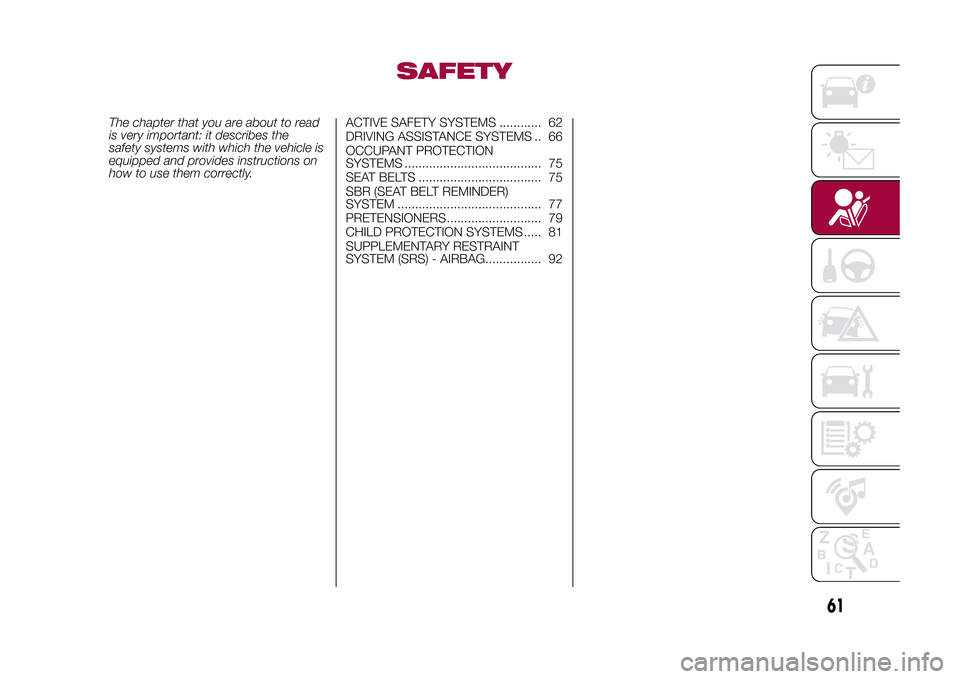
SAFETY
The chapter that you are about to read
is very important: it describes the
safety systems with which the vehicle is
equipped and provides instructions on
how to use them correctly.ACTIVE SAFETY SYSTEMS ............ 62
DRIVING ASSISTANCE SYSTEMS .. 66
OCCUPANT PROTECTION
SYSTEMS ....................................... 75
SEAT BELTS ................................... 75
SBR (SEAT BELT REMINDER)
SYSTEM ......................................... 77
PRETENSIONERS........................... 79
CHILD PROTECTION SYSTEMS ..... 81
SUPPLEMENTARY RESTRAINT
SYSTEM (SRS) - AIRBAG................ 92
61
15-12-2014 8:23 Pagina 61
Page 77 of 240
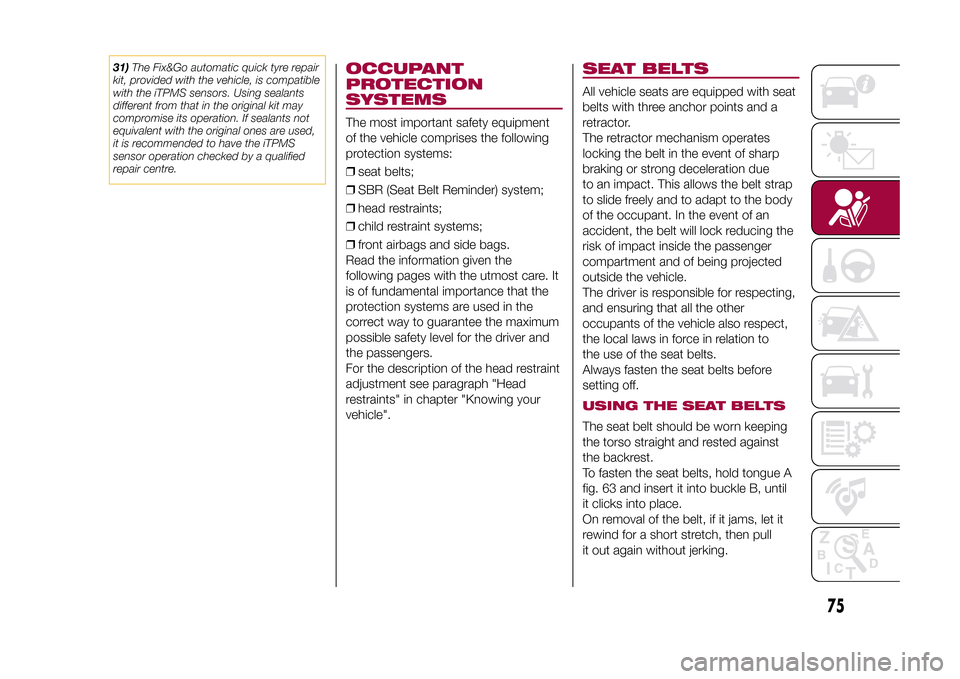
31)The Fix&Go automatic quick tyre repair
kit, provided with the vehicle, is compatible
with the iTPMS sensors. Using sealants
different from that in the original kit may
compromise its operation. If sealants not
equivalent with the original ones are used,
it is recommended to have the iTPMS
sensor operation checked by a qualified
repair centre.
OCCUPANT
PROTECTION
SYSTEMSThe most important safety equipment
of the vehicle comprises the following
protection systems:
❒seat belts;
❒SBR (Seat Belt Reminder) system;
❒head restraints;
❒child restraint systems;
❒front airbags and side bags.
Read the information given the
following pages with the utmost care. It
is of fundamental importance that the
protection systems are used in the
correct way to guarantee the maximum
possible safety level for the driver and
the passengers.
For the description of the head restraint
adjustment see paragraph "Head
restraints" in chapter "Knowing your
vehicle".
SEAT BELTSAll vehicle seats are equipped with seat
belts with three anchor points and a
retractor.
The retractor mechanism operates
locking the belt in the event of sharp
braking or strong deceleration due
to an impact. This allows the belt strap
to slide freely and to adapt to the body
of the occupant. In the event of an
accident, the belt will lock reducing the
risk of impact inside the passenger
compartment and of being projected
outside the vehicle.
The driver is responsible for respecting,
and ensuring that all the other
occupants of the vehicle also respect,
the local laws in force in relation to
the use of the seat belts.
Always fasten the seat belts before
setting off.USING THE SEAT BELTSThe seat belt should be worn keeping
the torso straight and rested against
the backrest.
To fasten the seat belts, hold tongue A
fig. 63 and insert it into buckle B, until
it clicks into place.
On removal of the belt, if it jams, let it
rewind for a short stretch, then pull
it out again without jerking.
75
15-12-2014 8:23 Pagina 75
Page 83 of 240
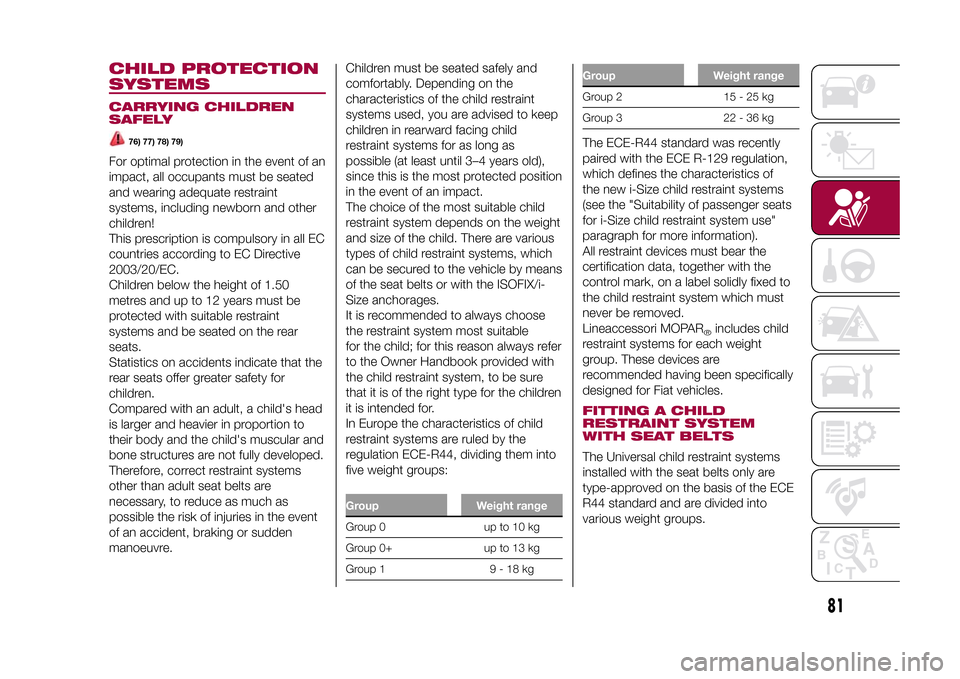
CHILD PROTECTION
SYSTEMSCARRYING CHILDREN
SAFELY
76) 77) 78) 79)
For optimal protection in the event of an
impact, all occupants must be seated
and wearing adequate restraint
systems, including newborn and other
children!
This prescription is compulsory in all EC
countries according to EC Directive
2003/20/EC.
Children below the height of 1.50
metres and up to 12 years must be
protected with suitable restraint
systems and be seated on the rear
seats.
Statistics on accidents indicate that the
rear seats offer greater safety for
children.
Compared with an adult, a child's head
is larger and heavier in proportion to
their body and the child's muscular and
bone structures are not fully developed.
Therefore, correct restraint systems
other than adult seat belts are
necessary, to reduce as much as
possible the risk of injuries in the event
of an accident, braking or sudden
manoeuvre.Children must be seated safely and
comfortably. Depending on the
characteristics of the child restraint
systems used, you are advised to keep
children in rearward facing child
restraint systems for as long as
possible (at least until 3–4 years old),
since this is the most protected position
in the event of an impact.
The choice of the most suitable child
restraint system depends on the weight
and size of the child. There are various
types of child restraint systems, which
can be secured to the vehicle by means
of the seat belts or with the ISOFIX/i-
Size anchorages.
It is recommended to always choose
the restraint system most suitable
for the child; for this reason always refer
to the Owner Handbook provided with
the child restraint system, to be sure
that it is of the right type for the children
it is intended for.
In Europe the characteristics of child
restraint systems are ruled by the
regulation ECE-R44, dividing them into
five weight groups:
Group Weight rangeGroup0 upto10kg
Group 0+ up to 13 kg
Group 1 9 - 18 kg
Group Weight rangeGroup 2 15 - 25 kg
Group 3 22 - 36 kgThe ECE-R44 standard was recently
paired with the ECE R-129 regulation,
which defines the characteristics of
the new i-Size child restraint systems
(see the "Suitability of passenger seats
for i-Size child restraint system use"
paragraph for more information).
All restraint devices must bear the
certification data, together with the
control mark, on a label solidly fixed to
the child restraint system which must
never be removed.
Lineaccessori MOPAR
®includes child
restraint systems for each weight
group. These devices are
recommended having been specifically
designed for Fiat vehicles.
FITTING A CHILD
RESTRAINT SYSTEM
WITH SEAT BELTSThe Universal child restraint systems
installed with the seat belts only are
type-approved on the basis of the ECE
R44 standard and are divided into
various weight groups.
81
15-12-2014 8:23 Pagina 81
Page 84 of 240
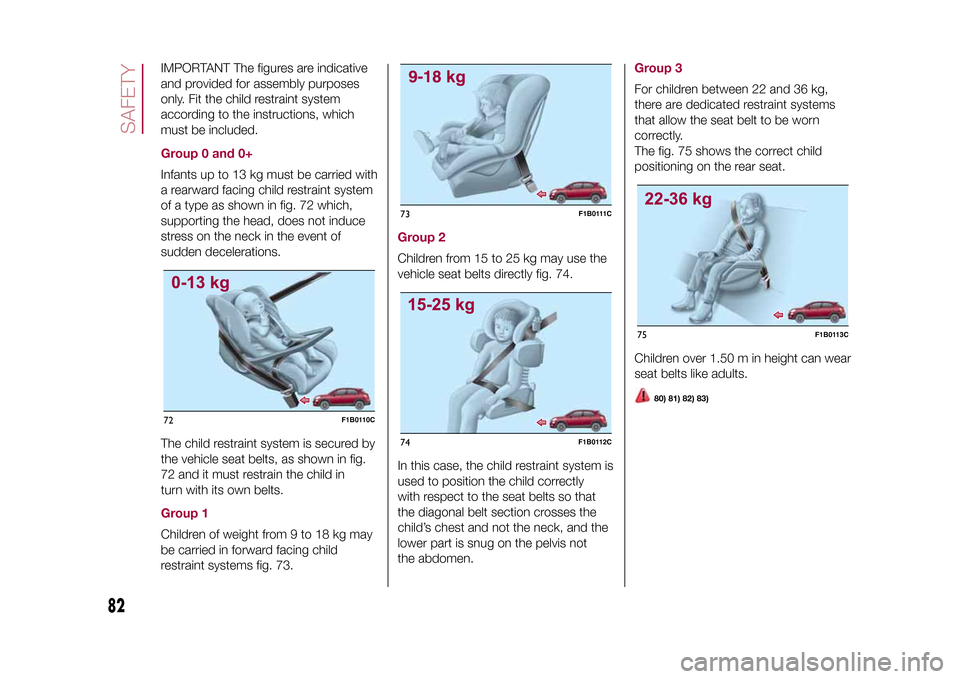
IMPORTANT The figures are indicative
and provided for assembly purposes
only. Fit the child restraint system
according to the instructions, which
must be included.Group 0 and 0+Infants up to 13 kg must be carried with
a rearward facing child restraint system
of a type as shown in fig. 72 which,
supporting the head, does not induce
stress on the neck in the event of
sudden decelerations.
The child restraint system is secured by
the vehicle seat belts, as shown in fig.
72 and it must restrain the child in
turn with its own belts.Group 1Children of weight from 9 to 18 kg may
be carried in forward facing child
restraint systems fig. 73.
Group 2Children from 15 to 25 kg may use the
vehicle seat belts directly fig. 74.
In this case, the child restraint system is
used to position the child correctly
with respect to the seat belts so that
the diagonal belt section crosses the
child’s chest and not the neck, and the
lower part is snug on the pelvis not
the abdomen.
Group 3For children between 22 and 36 kg,
there are dedicated restraint systems
that allow the seat belt to be worn
correctly.
The fig. 75 shows the correct child
positioning on the rear seat.
Children over 1.50 m in height can wear
seat belts like adults.
80) 81) 82) 83)
72
F1B0110C
73
F1B0111C
74
F1B011 2C
75
F1B0113C
82
SAFETY
15-12-2014 8:23 Pagina 82
Page 85 of 240
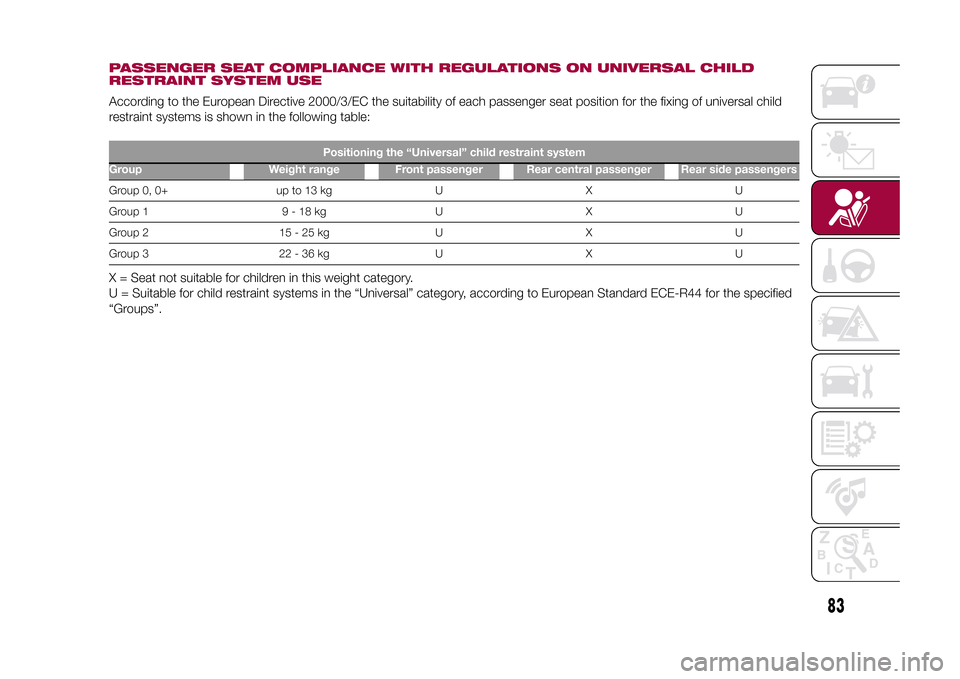
PASSENGER SEAT COMPLIANCE WITH REGULATIONS ON UNIVERSAL CHILD
RESTRAINT SYSTEM USEAccording to the European Directive 2000/3/EC the suitability of each passenger seat position for the fixing of universal child
restraint systems is shown in the following table:
Positioning the “Universal” child restraint system
Group Weight range Front passenger Rear central passenger Rear side passengers
Group 0, 0+ up to 13 kg U X U
Group 1 9 - 18 kg U X U
Group 2 15 - 25 kg U X U
Group 3 22 - 36 kg U X UX = Seat not suitable for children in this weight category.
U = Suitable for child restraint systems in the “Universal” category, according to European Standard ECE-R44 for the specified
“Groups”.
83
15-12-2014 8:23 Pagina 83
Page 86 of 240
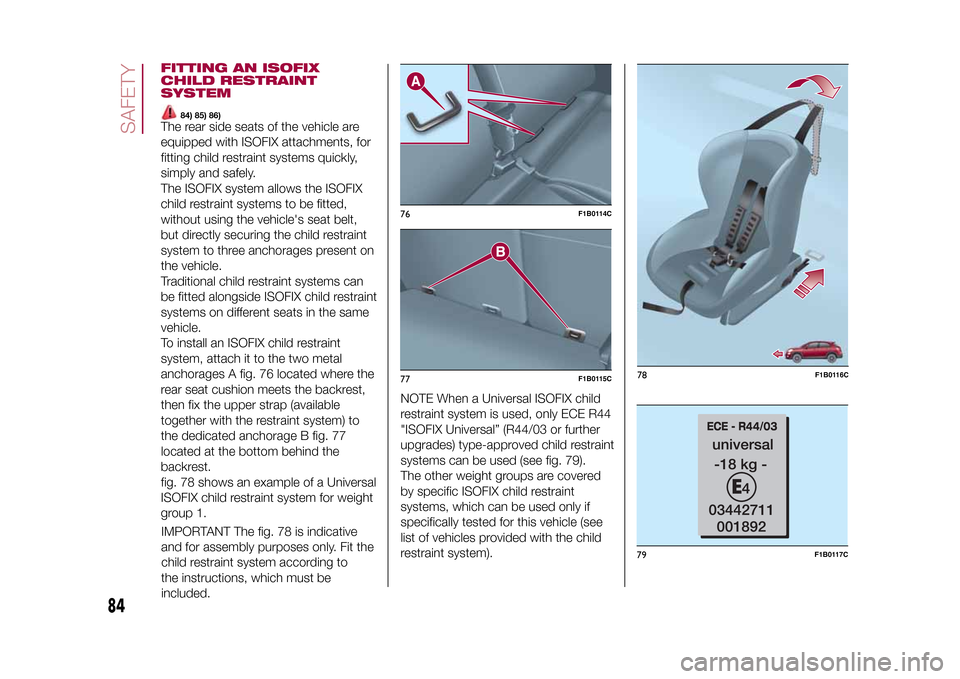
FITTING AN ISOFIX
CHILD RESTRAINT
SYSTEM
84) 85) 86)
The rear side seats of the vehicle are
equipped with ISOFIX attachments, for
fitting child restraint systems quickly,
simply and safely.
The ISOFIX system allows the ISOFIX
child restraint systems to be fitted,
without using the vehicle's seat belt,
but directly securing the child restraint
system to three anchorages present on
the vehicle.
Traditional child restraint systems can
be fitted alongside ISOFIX child restraint
systems on different seats in the same
vehicle.
To install an ISOFIX child restraint
system, attach it to the two metal
anchorages A fig. 76 located where the
rear seat cushion meets the backrest,
then fix the upper strap (available
together with the restraint system) to
the dedicated anchorage B fig. 77
located at the bottom behind the
backrest.
fig. 78 shows an example of a Universal
ISOFIX child restraint system for weight
group 1.
IMPORTANT The fig. 78 is indicative
and for assembly purposes only. Fit the
child restraint system according to
the instructions, which must be
included.NOTE When a Universal ISOFIX child
restraint system is used, only ECE R44
"ISOFIX Universal” (R44/03 or further
upgrades) type-approved child restraint
systems can be used (see fig. 79).
The other weight groups are covered
by specific ISOFIX child restraint
systems, which can be used only if
specifically tested for this vehicle (see
list of vehicles provided with the child
restraint system).
76
F1B0114C
77
F1B0115C
78
F1B0116C
84
SAFETY
15-12-2014 8:23 Pagina 84
79
F1B0117C
Page 87 of 240
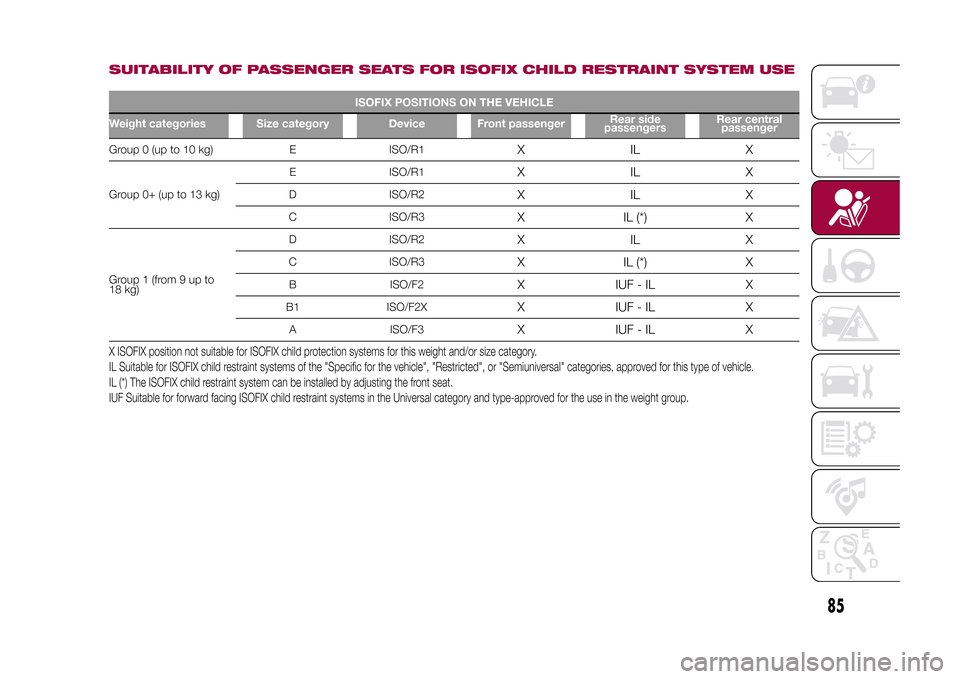
SUITABILITY OF PASSENGER SEATS FOR ISOFIX CHILD RESTRAINT SYSTEM USE
ISOFIX POSITIONS ON THE VEHICLE
Weight categories Size category Device Front passengerRear side
passengersRear central
passenger
Group 0 (up to 10 kg) E ISO/R1
XILX
Group 0+ (up to 13 kg)E ISO/R1
XILX
D ISO/R2
XILX
C ISO/R3
X IL (*) X
Group 1 (from 9 up to
18 kg)D ISO/R2
XILX
C ISO/R3
X IL (*) X
B ISO/F2
X IUF-IL X
B1 ISO/F2X
X IUF-IL X
A ISO/F3
X IUF-IL X
X ISOFIX position not suitable for ISOFIX child protection systems for this weight and/or size category.
IL Suitable for ISOFIX child restraint systems of the "Specific for the vehicle", "Restricted", or "Semiuniversal" categories, approved for this type of vehicle.
IL (*) The ISOFIX child restraint system can be installed by adjusting the front seat.
IUF Suitable for forward facing ISOFIX child restraint systems in the Universal category and type-approved for the use in the weight group.
85
15-12-2014 8:23 Pagina 85
Page 88 of 240
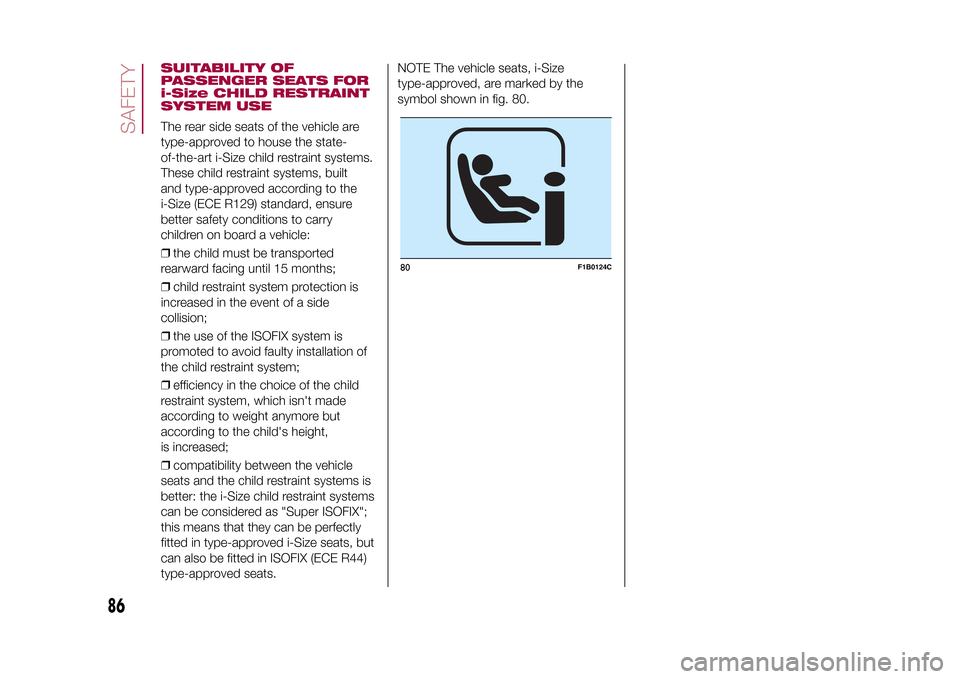
SUITABILITY OF
PASSENGER SEATS FOR
i-Size CHILD RESTRAINT
SYSTEM USEThe rear side seats of the vehicle are
type-approved to house the state-
of-the-art i-Size child restraint systems.
These child restraint systems, built
and type-approved according to the
i-Size (ECE R129) standard, ensure
better safety conditions to carry
children on board a vehicle:
❒the child must be transported
rearward facing until 15 months;
❒child restraint system protection is
increased in the event of a side
collision;
❒the use of the ISOFIX system is
promoted to avoid faulty installation of
the child restraint system;
❒efficiency in the choice of the child
restraint system, which isn't made
according to weight anymore but
according to the child's height,
is increased;
❒compatibility between the vehicle
seats and the child restraint systems is
better: the i-Size child restraint systems
can be considered as "Super ISOFIX";
this means that they can be perfectly
fitted in type-approved i-Size seats, but
can also be fitted in ISOFIX (ECE R44)
type-approved seats.NOTE The vehicle seats, i-Size
type-approved, are marked by the
symbol shown in fig. 80.
80
F1B0124C
86
SAFETY
15-12-2014 8:23 Pagina 86
Page 89 of 240
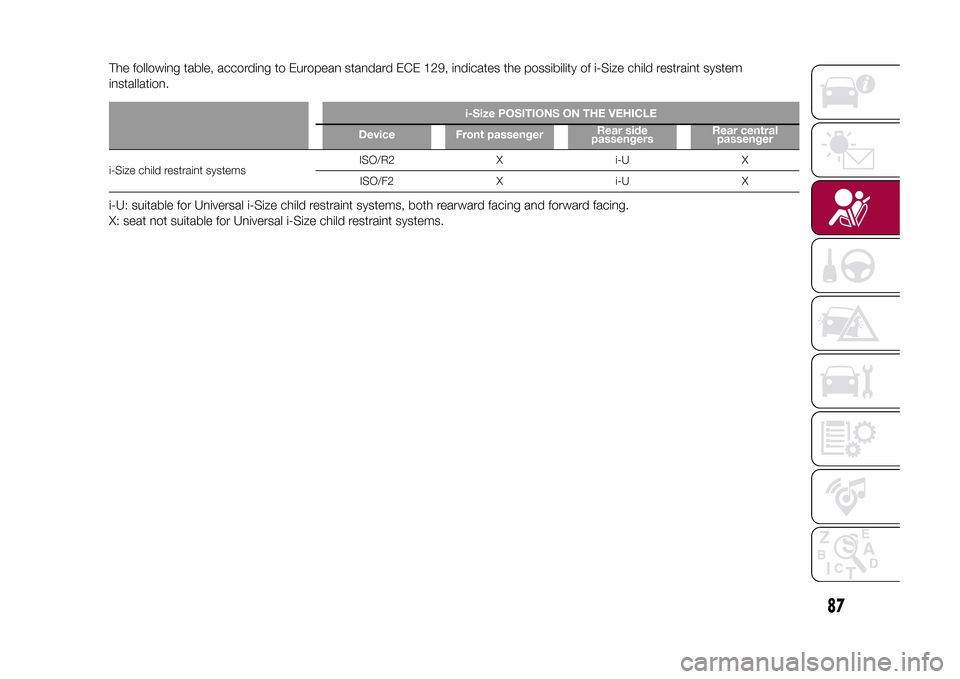
The following table, according to European standard ECE 129, indicates the possibility of i-Size child restraint system
installation.
i-Size POSITIONS ON THE VEHICLE
Device Front passengerRear side
passengersRear central
passenger
i-Size child restraint systemsISO/R2 X i-U X
ISO/F2 X i-U Xi-U: suitable for Universal i-Size child restraint systems, both rearward facing and forward facing.
X: seat not suitable for Universal i-Size child restraint systems.
87
15-12-2014 8:23 Pagina 87
Page 90 of 240
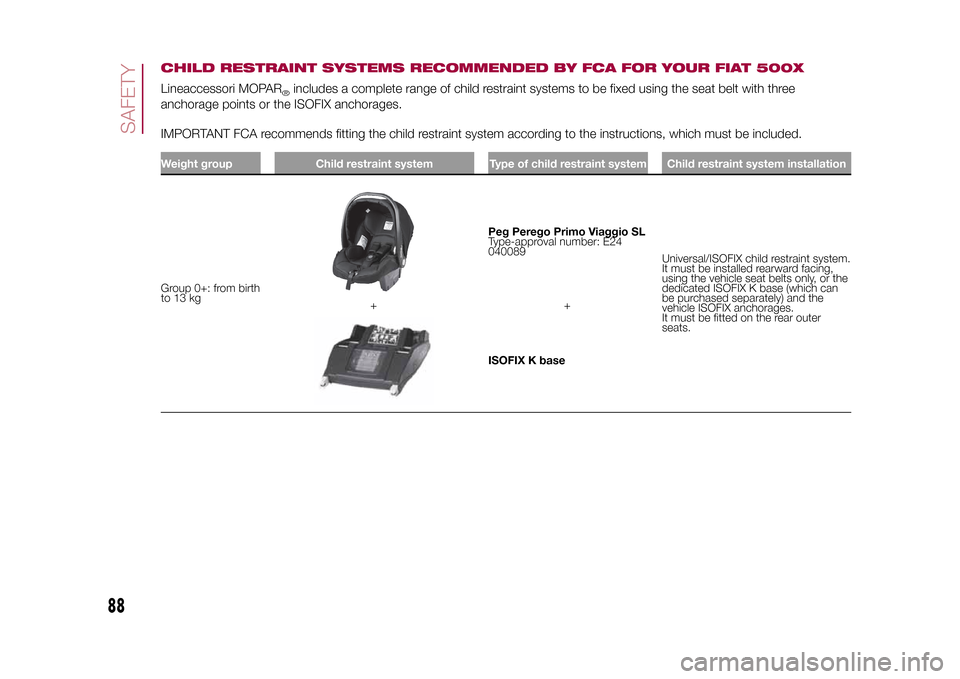
CHILD RESTRAINT SYSTEMS RECOMMENDED BY FCA FOR YOUR FIAT 500XLineaccessori MOPAR
®includes a complete range of child restraint systems to be fixed using the seat belt with three
anchorage points or the ISOFIX anchorages.
IMPORTANT FCA recommends fitting the child restraint system according to the instructions, which must be included.
Weight group Child restraint system Type of child restraint system Child restraint system installationGroup 0+: from birth
to 13 kg
Peg Perego Primo Viaggio SL
Type-approval number: E24
040089
Universal/ISOFIX child restraint system.
It must be installed rearward facing,
using the vehicle seat belts only, or the
dedicated ISOFIX K base (which can
be purchased separately) and the
vehicle ISOFIX anchorages.
It must be fitted on the rear outer
seats.ISOFIX K base
88
SAFETY
15-12-2014 8:23 Pagina 88
++